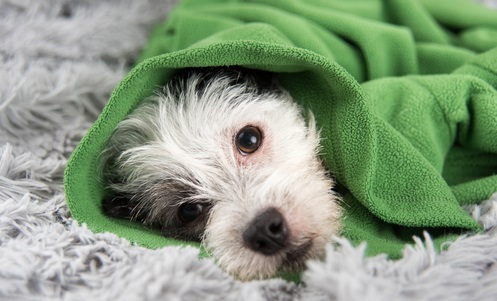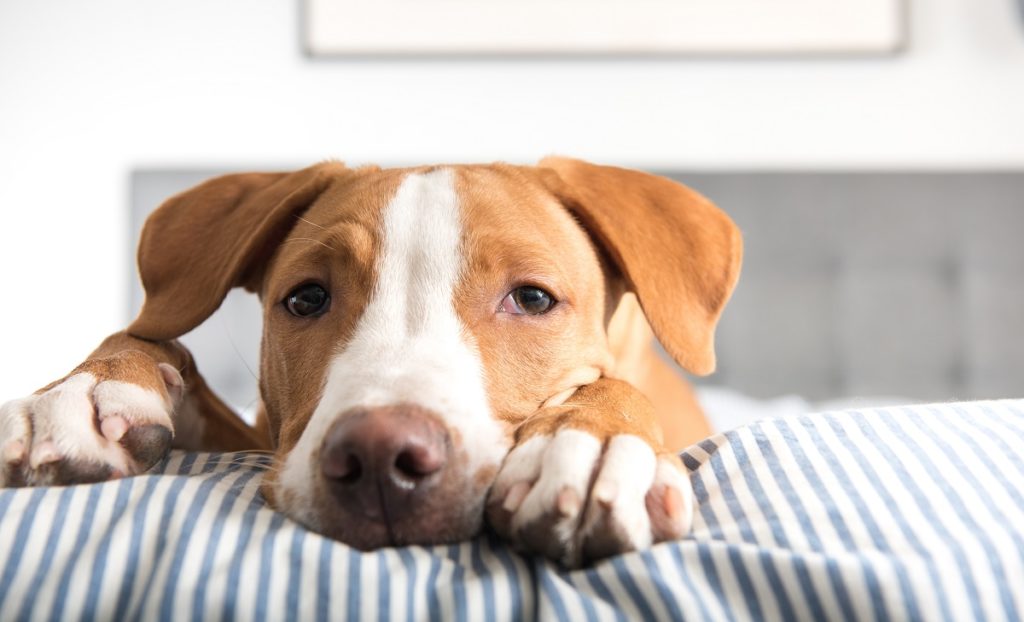It may not always be top of mind, but carbon monoxide poisoning poses a real threat – not only to humans, but pets, too. Odorless, colorless and invisible, this deadly gas is capable of killing people and animals who breathe it, especially in an enclosed space. Found in fumes any time fuel is burned in cars or trucks, small engines, lanterns, stoves, fireplaces, gas ranges or grills, it is capable of building up indoors undetected, where it can lead to fatalities. Although most households have at least one smoke detector, very few have carbon monoxide detectors. This article will address the dangers of carbon monoxide poisoning in dogs, including signs and symptoms, prevention, and helpful suggestions.
How Does Carbon Monoxide Poisoning In Dogs Occur?
 It only takes minutes before an accident can happen, so it’s important for dog owners to be aware of the dangers of carbon monoxide – and the impending harm it can cause everyone in the home, including their pets. When smoke or gas leaks from either fireplaces, engines, kerosene or propane equipment, it quickly builds up in low-ventilated areas (such as covered patios and garages) and can lead to a potential disaster. A poisonous gas, carbon monoxide (CO) is produced from car exhaust, outdoor generators and fires. In the instance of our four-legged companions, carbon monoxide poisoning takes place when a dog breathes in the odorless gas, which is then absorbed into the bloodstream. If inhaled in high enough amounts, CO causes oxygen starvation (i.e., hypoxia) to the cells of the body. And while CO is toxic to all species, young children, individuals who are sick or elderly, and pets are at a higher risk than average among households.
It only takes minutes before an accident can happen, so it’s important for dog owners to be aware of the dangers of carbon monoxide – and the impending harm it can cause everyone in the home, including their pets. When smoke or gas leaks from either fireplaces, engines, kerosene or propane equipment, it quickly builds up in low-ventilated areas (such as covered patios and garages) and can lead to a potential disaster. A poisonous gas, carbon monoxide (CO) is produced from car exhaust, outdoor generators and fires. In the instance of our four-legged companions, carbon monoxide poisoning takes place when a dog breathes in the odorless gas, which is then absorbed into the bloodstream. If inhaled in high enough amounts, CO causes oxygen starvation (i.e., hypoxia) to the cells of the body. And while CO is toxic to all species, young children, individuals who are sick or elderly, and pets are at a higher risk than average among households.
Potentially dangerous levels of CO gas may include:
- Airplane cargo space
- Automobile exhaust
- Barbecue grills
- Household fires
- Stoves
- Gas fireplaces
- Kerosene lanterns
- Kerosene space heaters
- Ovens
- Propane heaters
- Water heaters
Essentially, any slow gas leak or smoke found in areas where there is inadequate or poor ventilation (for example, rooms without open windows or vents and moving air) can expose both people and pets to hazardous levels of carbon monoxide.
Symptoms of carbon monoxide poisoning in dogs can span from mild to severe, and may include:
- Cardiac arrhythmias
- Depression
- Drowsiness/lethargy
- Dyspnea (difficult or labored breathing)
- Incoordination/wooziness
- Inflamed or red lips, ears and gums
- Intolerance to exercise
- Nausea
- Vomiting
- Acute lung injury
- Acute Respiratory Disease (ARDS)
- Neurological impairment (e.g., seizures, coma, deafness)
- Weakness
- Collapse
- Death
- Permanent deafness/blindness are also possible
If it’s suspected that a dog has been exposed to carbon monoxide gas, be sure to move him to an open space with fresh air right away. In the instance that he has no pulse/heartbeat or has collapsed, canine CPR may be performed by properly trained individuals. Ultimately, the dog must be taken to the vet immediately for a proper diagnosis and care. For dogs who have experienced CO poisoning, the vet will administer oxygen to the animal immediately while monitoring his vitals and oxygen levels. He may also be given intravenous (IV) fluids to return pH levels in the blood back to normal. Depending on the severity of poisoning, he may be given respiratory support or be hospitalized overnight until his condition has stabilized.
CO Poisoning: The Invisible Killer
Most pet owners will do whatever they can to protect their families from harm, and that includes their beloved dogs. And while it’s important to recognize the signs of carbon monoxide poisoning in people and pets, ultimately, prevention is the best approach. Fortunately, there are now dual detectors available that feature both smoke and carbon monoxide alarms. However, being vigilant and staying aware of the risks, signs and symptoms is the most proactive approach dog owners can take when it comes to CO poisoning.
 According to the CDC (Center for Disease Control), everyone is at risk for CO poisoning – in fact, each year, more than 400 Americans die from unintentional CO poisoning not linked to fires, while over 20,000 visit the emergency room, and more than 4,000 are hospitalized. Keeping those statistics in mind, the family dog is at risk as much as the average person, if not more, since animals depend on their caregivers exclusively – and are often left home alone for hours at a time. Therefore, it’s essential to keep a CO detector in the home at all times, and check the battery often to ensure it’s still functioning. For more CDC facts and preventative tips, click here.
According to the CDC (Center for Disease Control), everyone is at risk for CO poisoning – in fact, each year, more than 400 Americans die from unintentional CO poisoning not linked to fires, while over 20,000 visit the emergency room, and more than 4,000 are hospitalized. Keeping those statistics in mind, the family dog is at risk as much as the average person, if not more, since animals depend on their caregivers exclusively – and are often left home alone for hours at a time. Therefore, it’s essential to keep a CO detector in the home at all times, and check the battery often to ensure it’s still functioning. For more CDC facts and preventative tips, click here.
Did You Know…
In less than 15 minutes, small children and animals can die of carbon monoxide poisoning inside an enclosed vehicle. Knowing these sobering statistics, there are some precautions to follow in order to reduce the dangers of CO poisoning. As seen on Lifewire.com, “How to Avoid Carbon Monoxide Poisoning in Your Car”, consult this handy checklist in order to reduce your risks. As an added safety measure, you can even install a portable carbon monoxide detector.
Summary
Because carbon monoxide is colorless, odorless, tasteless and non-irritating, it is nearly impossible to detect its presence until it is too late, resulting in sickness and in worst-case scenarios, fatalities. That’s why it is so imperative for pet parents to maintain household items and machinery (e.g., equipment that uses gas, propane or kerosene) at all times, and do so in a well-ventilated area. Never leave dogs or other pets in an enclosed space without proper ventilation or fresh air sources. And finally, invest in a quality combination smoke and CO detector – it could save you and your pet’s life.
Sources Cited:
- “5 Signs Your Pet Has Carbon Monoxide Poisoning.” Vetted Petcare.com, March 26, 2018, https://vettedpetcare.com/vetted-blog/5-signs-pet-carbon-monoxide-poisoning/. Accessed May 29, 2019.
- “Protecting Your Pets and Your Family from Carbon Monoxide Poisoning.” APSCA.org, November 2, 2017, https://www.aspca.org/news/protecting-your-pets-and-your-family-carbon-monoxide-poisoning. Accessed May 29, 2019.
- “Carbon Monoxide Poisoning in Dogs.” Wagwalking.com, (no publish date), https://wagwalking.com/condition/carbon-monoxide-poisoning. Accessed May 29, 2019.




